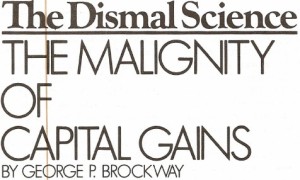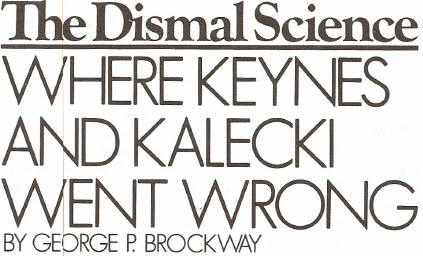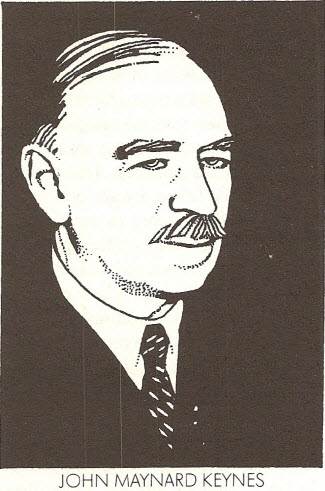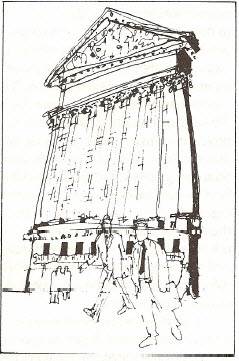By George P. Brockway, originally published September 21, 1992
THE RECURRING wrangle over the fairness or unfairness of capital gains taxation, while certainly not irrelevant, has distracted attention from the malign effects on the economy of the search for capital gains.
We hear on the one side that they are largely the concern of the rich, and of their pursuit by rapacious business executives. On the other side we are told tales of young men enabled to realize a great invention with the help of a timely investment by some capitalist with vision. We learn, too, of family farms and family businesses, of personal art collections, and of great tracts of unspoiled wilderness that would not be put to their best social uses if equitably taxed.
We hear all of these things, and most of them are true, or could be true. But we hear little or nothing about the influence of the search for capital gains on the stock market and, through the stock market, on the efforts of the Federal Reserve Board to stimulate the economy.
It is a source of much puzzlement that the Reserve’s well publicized three-year long assault on short-term interest rates has done, if anything, the opposite of what it was intended to do. Since the summer of 1989 the Reserve has cut short term interest rates more than 20 times. The expectation, of course, has been that lower rates would encourage producers to borrow and invest in plant expansion and modernization. The resulting increased employment, coupled with lower rates on consumers’ loans, would encourage consumers to buy, thus validating the producers’ expansions and setting the economy on a sustainable upward curve.
The plan made sense from almost every economic point of view, yet its failure is manifest. Producers are shutting down plants instead of opening new ones; unemployment has risen painfully; corporate profits and personal savings are both down; retail sales continue to be disappointing.
For most of the economy 1991 was a bad year, and 1992 is worse. But one sector flourished, and continues to flourish. Nearly all brokerage houses are prosperous, some of them more so than ever before. The stock exchanges, despite waffling between their January and July peaks, have been buying and selling at a record rate.
It has been a long time since Wall Street was primarily concerned about the business prospects of the firms whose shares the exchanges trade in the hundreds of millions every business day. Two statistics dominate the thinking of speculators. The first is unemployment, which is a worry because there is supposed to be a trade-off between unemployment and inflation. But in only three of the 46 years since the end of World War II has unemployment been higher than it is today; so regardless of the validity of the supposition, there is little fear of an imminent resurgence of inflation.
The other number that concerns Wall Street is the interest rate, because the capitalized value of any income-earning asset goes up as the interest rate goes down. The reaction of the secondary market for short- term bonds and notes is almost automatic. The long bond market, being congenitally fearful of inflation, follows at a more circumspect pace. As the prices of bonds rise, common stocks become more attractive investments, both for income and for capital gains.
Therefore, as the Federal Reserve Board has lowered the interest rate, the stock market has climbed. Investors especially speculators eager for capital gains-have rushed to take advantage of the quick profits. Money has poured into the stock market.
Now, that money obviously had to come from somewhere, and its ultimate source had to be the producing economy, where things are made and sold and services are performed and paid for. It may be old money from CDs and money market funds and bonds, or it may be new money borrowed at the new interest rates. In either case, it is money that the rising stock market denies to the producing economy. The lower interest rates, instead of stimulating the producing economy, have caused money to be drained away from it. Hence the deplored credit crunch.
Unfortunately, there is nothing the Federal Reserve Board can do about this. A continuation of the policy of lowering the interest rate will lead to a continuation of its consequences. A determination to stand pat will leave us in our present doldrums. A reversal of policy, raising the interest rate, will not only deepen the recession but very likely cause the market to crash. Moreover, when the market crashes the money that is lost simply disappears. It is not returned to the producing economy, nor does it reappear as cash in someone’s pocket.
Gross private domestic investment, as a percentage of GNP, was practically unchanged in 1986, 1987, and 1988 (the year before the crash, the year of the crash and the year after the crash). The percentages were 13.5, 13.1, and 13.8, respectively. As for cash, M1, which includes it, fell in 1987 as the market fell. The lost money was gone forever.
Was the Reserve wrong, then, to reduce the interest rate? Certainly not. Usurious rates are largely responsible for the recession, and still lower rates will be necessary to end it. It is true that the discount rate is now lower than it has been for 30 years. It is also true that it is three times what it was in 1947 and six times what it was on special advances in 1946.
Although the Reserve Board’s recent intentions bay be good, they have been, and will continue to be, overwhelmed by the altogether understandable rapacity of seekers after capital gains. It’s easy to make money on a rising market, but you have to risk a dollar to make a dollar. The dollars that you risk are dollars you might have risked in buying a new machine for your factory or in replenishing the inventory of your store. Your broker will try to tell you that by buying a share of stock you are producing goods just as much as if you were buying a machine for your factory. But of course the stock and the machine don’t both produce goods and it takes time to make money with the machine, while you can do that on the stock exchange very fast. So if you’re smart, you will play the market, and the Federal Reserve Board will be frustrated.
If the Federal Reserve cannot get us out of this mess we are in who can? Unwittingly, President Bush has pointed the way – even though, characteristically, he was looking in the other direction. He has proposed a low capital gains tax, and a still lower tax on gains on some assets held more than five years. It won’t take you very long to see that his proposal would merely make more attractive the speculation that drains money from the producing economy.
Yet a sliding tax scale could take the profit out of speculating. If I had my druthers, I would have a capital gains tax that went something like this: Gains on some assets held more than five years would be taxed at 95 per cent, gains on assets held more than a year but less than two years would be taxed at 90 per cent, and so on, with the rate falling 5 points a year for 10 years.
Some changes in the tax law should be made regardless of the rates. Gains certainly should be taxed when assets change hands by gift or bequest as well as by sale. Capital gains of otherwise tax-exempt institutions should be taxed, because such institutions are responsible for much of the current market churning. On the other hand, it would be desirable to exempt principal family residences that fall below a certain value, along with small family farms and businesses.
Capital gains are an archaic form of profit. Despite their name, they are typical not of the capitalist system, but of mercantilism and more primitive economic systems. Likewise, the speculation that gives rise to them is an archaic form of economic enterprise. In the Renaissance the merchants of Venice organized each commercial voyage as a separate affair. Their personal experience taught them the sorts of goods most likely to be wanted on the Golden Horn. They stocked their outward bound galleys accordingly, and they brought home the sorts of things they could sell quickly and profitably at the quayside. The system was a series of speculative ventures, making the most of ad hoc opportunities to buy cheap and sell dear. When the selling was ended, the enterprise was ended, too. Capital gains are realized only when an investment is withdrawn and ceases.
In contrast, a modern corporation is a continuing enterprise. The basic concepts of classical and neoclassical economics are irrelevant to it. It could not continue if its market were “cleared.“ Since its market is not cleared, the “law” of diminishing returns is obviously violated. If the law of diminishing returns does not apply, there is no “margin,” and marginal pricing is impossible. If marginal pricing is impossible, “equilibrium” is neither necessary, likely, nor desirable. (And this is a good thing, for as all theorists from Leon Walras to Gerard Debreu acknowledge, economies of scale – the ideal mode of modern business enterprise – are impossible under equilibrium.)
Four years ago it was argued (fallaciously) by candidate George Bush that reducing the capital gains tax would increase tax collections (see “George Bush’s New Trojan Horse,” NL, September 19, 1988). His lips seem to be buttoned shut on that one today. Now we are told that reducing the tax would stimulate business, a notion dear to the far Right, which nevertheless mysteriously mistrusts him. But surely the Federal Reserve Board has had enough experience in the past three years to prove that to encourage capital gains is to encourage speculation, and that to encourage speculation is to induce a credit crunch that throttles productive enterprise.
A low capital gains tax is unfair because it is for the principal benefit of the rich. It is also economically counterproductive.
The New Leader













